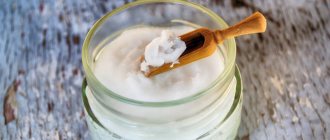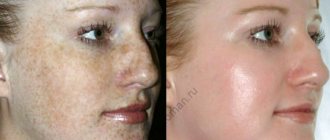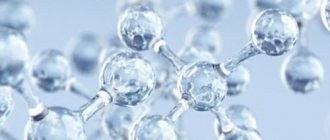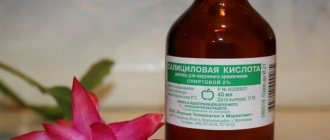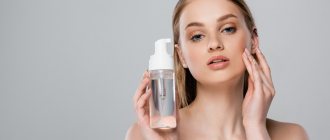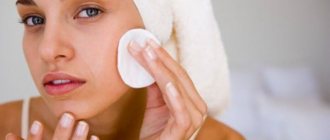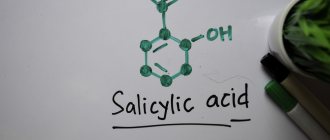How a lack of hyaluronic acid leads to skin aging -
Almost all of the skin's hyaluronic acid is located in its dermal layer (Fig. 2) - exactly where the collagen and elastin fibers responsible for skin elasticity are located. Loss of moisture (dehydration) from this layer of skin leads to the following effects:
- Slow collagen degeneration - a decrease in the amount of hyaluronic acid leads to a decrease in water content in the dermis, which leads to weak hydration of collagen and elastin fibers with water. Under these conditions, slow degeneration of collagen fibers occurs with a gradual decrease in its quantity. In addition, all other collagen loses the proper degree of plasticity (ability to shrink/decompress). And this affects the elasticity of the skin.
- Reduced skin thickness – dehydration of the dermal layer of the skin leads to a decrease in its thickness, accordingly, the skin becomes thinner and less elastic. Thin skin is more prone to the early appearance of wrinkles.
- Reduced activity of fibroblasts and keratinocytes - fibroblasts are responsible for the synthesis of collagen and elastin. When there is a lack of hyaluronic acid, their activity decreases, which affects their collagen production. The activity of keratinocytes, on which the thickness of the epidermal layer of the skin depends, also decreases. A decrease in the thickness of the epidermis leads to a decrease in the protective properties of the skin and to greater evaporation of water from its surface.
Hyaluronic acid for the face: reviews from cosmetologists... thus, the additional supply of hyaluronic acid (with a decrease in its content in the dermis) helps ensure that the dermis is saturated with moisture and the collagen remains sufficiently hydrated with water. Plus, the activity of fibroblasts and keratinocytes increases, stimulates angiogenesis, cell regeneration, and metabolic processes. All this keeps the skin well hydrated, elastic and, accordingly, prevents the development of wrinkles.
Arguments for the use of low molecular weight HA
Argument #1. With age, the amount of hyaluronic acid in the epidermis decreases. Since NM-HA is able to penetrate deeper into it, it moisturizes the skin more effectively, restoring the “reserves” of its own HA.
First, research does indicate that GC content in the epidermis decreases with age. Lee, D., Oh, J. and Chung, J. (2016). Glycosaminoglycan and proteoglycan in skin aging. Journal of Dermatological Science, 83(3), pp.174-181.. It's true.
Secondly, research also indicates that LMW-HA penetrates deeper into the skin more easily Essendoubi, M., Gobinet, C., Reynaud, R., Angiboust, J., Manfait, M. and Piot, O. (2015) . Human skin penetration of hyaluronic acid of different molecular weights as probed by Raman spectroscopy. Skin Research and Technology
, 22(1), pp.55-62. Nashchekina, Y. and Raydan, M. (2017). Noninvasive penetration of 5 nm hyaluronic acid molecules across the epidermal barrier (in vitro) and its interaction with human skin cells. Skin Research and Technology, 24(1), pp.129-134. Farwick, M., Gauglitz, G., Pavicic, T., Köhler, T., Wegmann, M., Schwach-Abdellaoui, K., Malle, B., Tarabin, V., Schmitz, G. and Korting, H. (2011). Fifty-kDa Hyaluronic Acid Upregulates Some Epidermal Genes without Changing TNF-α Expression in Reconstituted Epidermis. Skin Pharmacology and Physiology, 24(4), pp.210-217. Scientists also agree with this.
(
)
But in terms of its positive effect on the epidermis, everything is more complicated.
Pros
There is a study showing that the use of LMW-HA promotes epidermal repair. Bourguignon, L., Wong, G., Xia, W., Man, M., Holleran, W. and Elias, P. (2013). Selective matrix (hyaluronan) interaction with CD44 and RhoGTPase signaling promotes keratinocyte functions and overcomes age-related epidermal dysfunction. Journal of Dermatological Science, 72(1), pp.32-44. External application of LMW-HA led to activation of keratinocytes. Keratinocytes are cells found in the top layer of our skin, the epidermis.
In the epidermis, they are responsible for the production of hyaluronic acid (not fibroblasts, as in the dermis). Therefore, it is likely that LM-HA even stimulates the synthesis of its own hyaluronic acid in the upper layer of the skin. (But this has not been confirmed yet).
Moreover, the layer of skin becomes thicker, which is also good.
Unfortunately, there are no reliable studies yet that directly ask, “What is more effective – products with LMW-HA or products with HMW-HA?” Therefore, you will have to believe the research from the manufacturing companies themselves. They show that only NM-HA creams smoothed out wrinkles in women after 2 months of daily use. Women were asked to apply the cream twice a day. By NM-HA we mean creams with HA 50 kDa and 130 kDa. Source: Pavicic, T., Gauglitz, G., Lersch, P., Schwach-Abdellaoui, K., Malle, B., Korting, H. and Farwick, M. (2011). Efficacy of cream-based novel formulations of hyaluronic acid of different molecular weights in anti-wrinkle treatment. J Drugs Dermatol., 10(9), pp.990-1000. All creams had a moisturizing effect.
Cons
Although LMW-HA has a positive effect on keratinocytes and skin thickness, it does not restore the skin barrier. Bourguignon, L., Wong, G., Xia, W., Man, M., Holleran, W. and Elias, P. (2013). Selective matrix (hyaluronan) interaction with CD44 and RhoGTPase signaling promotes keratinocyte functions and overcomes age-related epidermal dysfunction. Journal of Dermatological Science, 72(1), pp.32-44. This is bad because a compromised skin barrier is one of the main causes of dryness. Verdier-Sévrain, S. and Bonté, F. (2007). Skin hydration: a review on its molecular mechanisms. Journal of Cosmetic Dermatology, 6(2), pp.75-82..
The water “leaves”, but we want it to remain in the skin.
VM-HA, on the contrary, has virtually no effect on skin thickness and keratinocyte proliferation, but, on the other hand, restores the skin barrier.
Interesting, isn't it?
Therefore, perhaps there is no need to argue which is cooler, NM-GK or VM-GK, but you just need to combine them!
First, NM-HA (to activate keratinocytes), then VM-HA (to restore the skin barrier).
The study above did just that and found that combining both treatments produced better results. Bourguignon, L., Wong, G., Xia, W., Man, M., Holleran, W. and Elias, P. (2013) . Selective matrix (hyaluronan) interaction with CD44 and RhoGTPase signaling promotes keratinocyte functions and overcomes age-related epidermal dysfunction. Journal of Dermatological Science, 72(1), pp.32-44..
This is probably what I would have recommended to you, if not for the research below...
Argument #2. NM-HA penetrates not only into the epidermis, but, to some extent, also reaches the middle layer of the skin - the dermis. Thus, we stimulate fibroblasts, which, in turn, promotes the synthesis of our own hyaluronic acid.
This would be cool - after all, if this is really the case, then to some extent (albeit limited) we can reproduce a similar effect to what we are trying to achieve with biorevitalization.
Namely: to force the dermis to produce its own HA, form new collagen and elastin (real anti-age!).
But there are currently several problems with this theory:
- Even in the most recent study, which used the smallest HA chains (~2 kDA), scientists argue that the possibility of HA penetration through the epidermis into the dermis remains questionable. Nashchekina, Y. and Raydan, M. (2017). Noninvasive penetration of 5 nm hyaluronic acid molecules across the epidermal barrier (in vitro) and its interaction with human skin cells. Skin Research and Technology, 24(1), pp.129-134.
- And even if NM-HA gets into the dermis, it is unclear whether this is a good thing.
Why don’t all external products with hyaluronic acid work?
Hyaluronic acid belongs to the class of polysaccharides, or more precisely glycosaminoglycans. It consists of repeating fragments (Fig. 3), which are usually called disaccharide units. Normally, one hyaluronic acid molecule contains up to 25 thousand of these repeating fragments. As a result, the molecule is a ribbon (Fig. 4), which is rolled into a loose tangled ball.
Hyaluronic acid molecules are large in size and molecular weight, and therefore they normally do not penetrate the skin - deeper than the cracks between dead epidermal cells. Therefore, some manufacturers use low molecular weight hyaluronic acid in their creams and serums, which has been artificially reduced to a size that allows it to penetrate the skin well.
Therefore, the size of HA molecules in skin products is very important! The size (mass) of hyaluronic acid molecules is measured in daltons (Da). A standard hyaluronic acid molecule has a mass of up to 25,000,000 Da. In some sources you may find mass notation in the form of kDa (kilo Dalton). So, for example, 25,000,000 Dalton = 25,000 kDa).
Low molecular weight hyaluronic acid –
Low molecular weight molecules are considered to be hyaluronic acid molecules with a chain size of less than 130,000 Daltons. Such molecules penetrate the difficult skin barrier much more easily. Having penetrated the dermal layer of the skin, such molecules absorb water from the inside (which penetrates the dermis through the walls of blood vessels). By binding and holding it, they saturate the dermis with moisture.
But even low molecular weight HA is heterogeneous. Different size chains have completely different effects. Therefore, the best manufacturers use low molecular weight HA in their products not of one size, but of different sizes...
- Chains weighing from 400 to 10,000 Daltons - they most contribute to angiogenesis, i.e. the appearance of many microvessels in the dermis. This leads to better blood supply to the skin, which means better saturation of it with oxygen, nutrients, and activation of metabolic processes in the skin.
- Chains weighing from 50,000 to 130,000 Daltons - this size of molecules leads to good saturation of the dermis with moisture, but this size of chains especially stimulates cell proliferation and migration, increases the activity of fibroblasts + the production of new collagen. The activity of keratinocytes also increases, which helps to increase the thickness of the epidermis and increase its hydrophobic properties (i.e., the thicker the epidermis, the less moisture will evaporate from the surface of the skin).
Important : studies have shown that HA chains weighing up to 1 million Daltons can pass through the skin. However, the same studies showed that HA chains weighing from 500,000 to 1,000,000 Daltons (they are already considered high molecular weight) partially cause the opposite effects. Although they saturate the dermis with moisture, they also suppress the proliferation of fibroblasts, collagen synthesis, and angiogenesis (24stoma.ru).
High molecular weight hyaluronic acid –
Molecules of hyaluronic acid with a chain size greater than 130,000 Daltons are considered high molecular weight. But that doesn't mean they don't work. High molecular weight hyaluronic acid forms a thin gel-like “polymer” film on the surface of the skin, which begins to very quickly absorb moisture from the air.
The formation of a gel-like film leads to the following effects:
- an increase in water content in the epidermal layer of the skin,
- an additional barrier appears for the evaporation of moisture from the skin surface,
- The polymer film allows the biologically active components included in the cosmetic product to contact the skin longer and more closely, which increases their absorption.
Important : the greater the molecular weight of the hyaluronic acid used (we remind you that its maximum weight = 25,000,000 Daltons), the higher the effectiveness and duration of action of such a gel-like film.
Types of mesotherapy with hyaluronic acid for the face
Cosmetologists use various methods of performing the procedure. It can be injected or non-injected - it depends on the method of introducing the drug into the skin.
- Injection mesotherapy with hyaluronic acid
This format is classic. Using a needle, the mesococktail with active substances is introduced according to the scheme, which is marked in advance.
Injections of the drug can be carried out using two techniques:
- manually (with a syringe with a microneedle);
- factional.
In fractional mesotherapy, hyaluronic acid is simultaneously applied to one area of the skin with several needles using a special device. Using this technique increases the cost of the procedure, but it has many advantages. The method cannot be used on delicate areas of the eyes, neck and nose.
Recommended articles on the topic:
- Facial mesotherapy procedure: pros and cons
- Beauty injections: types of drugs, reviews
- Placental therapy is the secret of eternal youth
- Non-injection mesotherapy with hyaluronic acid
With the help of this innovative development, cosmetologists administer the cocktail without damaging the skin. Additional stimulating devices help the components reach the desired layers of the epidermis.
The non-injection technique is divided into:
- cryomesotherapy (uses cold and electric waves);
- laser therapy;
- iontophoresis (use current);
- magnetophoresis (magnetic waves are used);
- oxygen mesotherapy;
- ultraphonophoresis (using ultrasound);
- aquaphoresis (using laser, electric waves, lymphatic drainage).
Using a non-invasive technique, the procedure can be performed on patients who are afraid of injections or who are prohibited from injections. But for deep penetration of the drug, a larger number of procedures will be necessary.
CONCLUSIONS on choosing skin products -
Thus, HA molecules of different masses work completely differently. This can influence the choice of skin care products, depending on what you expect from using such products.
- Products with low molecular weight hyaluronic acid will work from the inside, penetrating the dermal layer of the skin, increasing its water content, which leads to an increase in the degree of hydration of collagen and elastin and an increase in their elasticity.
They also activate the function of fibroblasts and keratinocytes, increase collagen production, increase metabolic processes in the skin, and stimulate angiogenesis. Studies have shown that products with HA molecules from 50,000 to 130,000 Daltons are better than others in helping to restore skin elasticity. Just keep in mind that HA molecules are destroyed in the body over time: from less than a day to 2 days. Therefore, these products must be used constantly, otherwise you will slip back to the original skin condition. Moreover, the smaller the size of HA molecules, the faster they are destroyed by macrophages.
- Products with high molecular weight hyaluronic acid - the size of the HA molecules in such products should be at least 1,000,000 Daltons (and this is the worst option).
In the best case, the molecules should have a maximum size, i.e. approaching 25,000,000 Daltons. Keep in mind that such products can, on the contrary, dry out your skin if the surrounding air is not sufficiently humidified, i.e. dry In this case, the gel-like film will tend to absorb water even from the surface layer of the skin. These products allow you to quickly moisturize and improve the condition of the most superficial layer of skin (epidermis). You shouldn’t count on an increase in moisture in the dermis and an increase in skin elasticity. The effectiveness of such products will be much higher if, in addition to HA, they contain ceramides (unsaturated fatty acids), which also prevent the evaporation of moisture from the surface of the skin.
Hyaluronic acid in cosmetology –
Why is hyaluronic acid attractive in cosmetology, and what are its benefits? In addition to external agents, there are injection forms of administration, which can be aimed either at a general improvement in the condition of the skin or at smoothing out wrinkles.
Deep hydration of the skin of the face and neck –
The method of skin rejuvenation with injections of hyaluronic acid is called biorevitalization (from the words - renewal, revitalization). The hyaluronic acid solution is administered intradermally using multiple microinjections using a special automatic injector or syringe (Fig. 5-7). Solutions for biorevitalization can also contain all kinds of vitamins and amino acids.
Hyaluronic acid: reviews of biorevitalization techniques... we have already written similarly about the results of clinical studies of skin biorevitalization. Today this technique is quite controversial. If an increase in the production of collagen and elastin after injections of hyaluronic acid occurred (only in one study), it was still only at the level of statistical error. But in general, patients noted that the skin looked more rested after the injections for about a month.
Original photos from a study on the effectiveness of biorevitalization, taken before and after (can you see the difference?)
What explains the slight increase in collagen levels - it must be said that this method is carried out using a series of numerous micro-injections, which lead to numerous small injuries to the skin with a needle. The skin instantly reacts to any damage by activating regenerative mechanisms, including collagen production, activation of angiogenesis and blood supply. In our opinion, the improvement in skin condition with this technique occurs precisely because of the punctures of the skin, and not due to the contents of the syringe.
By the way, this is also proven by the fact that in one of the studies ( read the study ) an uneven increase in collagen was found, precisely in the places where the skin was punctured with a syringe needle. Considering that the hyaluronic acid solution spreads throughout the tissues upon injection, it is quite strange that the increase occurred only at the points where the needle was inserted into the skin.
By the way, look how the condition of the skin improves when exposed to a fractional laser, when using darsonvalization (discharges leave pockets of micronecrosis in the skin, which stimulate skin regeneration). Or like after using badyagi, which injures the skin with microneedles - after 2 days the skin tone becomes much healthier and even. All this proves our point.
Undoubtedly, the contents of the syringe affect metabolic processes to some extent, but this effect is extremely small and short-lived. In addition to injections, there is also hyaluronic acid in tablets, creams with sodium hyaluronate or hyaluronic acid (read about them below).
Smoothing wrinkles, adding volume to lips, cheekbones –
In cosmetology, hyaluronic acid is also used as a basis for fillers (dermal fillers), which are intended to correct wrinkles, or to increase the volume of lips or cheekbones. Hyaluronic acid fillers are a gel that is injected subcutaneously with a syringe. The gel has the property of not dissolving for a long time (up to 1 year), which achieves the lifting effect.
The principle of smoothing wrinkles with fillers with hyaluronic acid –
The effect of using fillers is visible immediately after the procedure. But you need to take into account that smoothing wrinkles or increasing the volume of cheekbones or lips will be temporary, because... The gel tends to slowly dissolve in the body. On average, the effect lasts for a period of 6-12 months (depending on the brand of filler chosen).
But there are long-acting fillers, the effect of which can last from 2 to 10 years. They are no longer made from hyaluronic acid, but based on suspended calcium hydroxyapatite, poly-L-lactic acid, and polymethyl methacrylate microspheres.
Indications for mesotherapy
To eliminate problems and achieve the desired result, be sure to consider the indications for use. If you identify skin imperfections in advance and compare them with the proposed list for a given cosmetic service, then before going to the clinic you will know whether mesotherapy will help you.
Using the procedure you can get rid of:
- wrinkles (both small and deeper);
- dry and oily skin;
- acne and acne marks;
- flabbiness of the epidermis;
- loss of elasticity;
- fuzzy oval face;
- acne;
- rosacea;
- double chin;
- scars, scars and stretch marks;
- age spots;
- traces of peeling or grinding.
With the help of mesotherapy, you can rejuvenate the skin and eliminate imperfections from the age of 18. With the appearance of the first age-related changes, the lifting effect of this procedure, which is indicated for women with aging skin, is especially effective.
Mesotherapy for rejuvenation is widely used and is practically harmless, but contraindications include diseases that can be caused by injections.
A doctor or cosmetologist must warn you about contraindications for mesotherapy with hyaluronic acid. These include:
- frequent allergies;
- intolerance to the composition of the meso cocktail;
- oncology;
- high blood pressure;
- decreased immunity;
- inflammation in the injection area;
- hemophilia;
- diabetes;
- problems with the heart and blood vessels.
It is recommended to refrain from mesotherapy procedures during pregnancy and lactation. At the same time, the cosmetologist is obliged to warn you about the possible negative effects of cocktails, since their effect on the child has not been fully studied. About 85% of cases of complications and side effects were observed in patients who had contraindications for mesotherapy with hyaluronic acid. You need to undergo an examination if you are not sufficiently aware of the health status of your body.
SOLGAR hyaluronic acid tablets: reviews
In the Russian segment of the Internet, Solgar, hyaluronic acid in tablets, is gaining great popularity. The manufacturer claims that taking this drug improves the condition of the joints, penetrating into the interarticular fluid, and also improves the condition of the skin, moisturizes it, fights wrinkles, and so on.
The fact is that hyaluronic acid molecules are too large, and therefore, when taken in tablets, they are not able to be absorbed in the intestines and penetrate into the blood. Accordingly, hyaluronic acid does not penetrate either into the joints or into the skin... The effect can generally only come from either the injectable form or the form for topical use (creams, serums), but not from tablets.
However, some reviews insist that hyaluronic acid in capsules/tablets can be perfectly absorbed in the body and improve its general condition. This is an outright lie, left by paid commentators in forums and thematic blogs, not supported, banally, by either the laws of biochemistry or the laws of human physiology.
Solgar hyaluronic acid: reviews from experts... on the seller’s website page you will, of course, see only positive reviews. Everything about the quality of these reviews is already clear, given that hyaluronic acid is not absorbed at all in the intestines. However, Solgar hyaluronic acid capsules also contain a large dose of vitamin C (as much as 167% of the daily dose in one capsule), which is absorbed in the intestines.
Vitamin C is a good antioxidant and immunomodulator, and of course can improve the general condition of the body. It is clear that if a stimulating effect occurs, it is only due to the presence of this vitamin. For information, Solgar hyaluronic acid price will range from 1200 to 2300 rubles (for 30 capsules). Isn't that a lot for vitamin C alone?
Even if you try (even if you spend a year), you will not find a single clinical study that has been conducted on the effectiveness of oral administration of hyaluronic acid in tablets or capsules. Of course, it is absolutely harmless, but taking it in tablets is absolutely pointless.
How do professionals treat pigmentation?
During the course of procedures carried out in the clinic, doctors first of all prescribe restorative, sedatives, and also during daylight hours, sunscreen with a high SPF, from 30 to 50.
At the end of the course, in winter, the cosmetologist will select a cream with retinol or fruit acids in low concentration, and in the summer - serum with vitamin C, the content of which is at least 10%.
The doctor also prescribes the intake of antioxidants - such as vitamin C, E, ubiquinone, bioflavonoids.
Upon completion of the first stage (course of procedures), cosmetologists prescribe the second stage - home care, which works in two directions: exfoliating procedures aimed at renewing the skin and reducing the production of melanocytes - pigment-producing cells.
The frequency of application of bleaching agents depends on the concentration of the substance contained in them.
They can be used daily or once a week at night. The duration of the course is determined by the doctor.
Hyaluronic acid injections –
There are two types of hyaluronic acid injections for skin rejuvenation. In the first case, a solution of hyaluronic acid is used, which quickly dissolves when administered intradermally. In the second case, hyaluronic acid gel is used, which does not dissolve in tissues for a long time. These two forms of application have completely different properties and effects...
- Use of hyaluronic acid solutions – injections of hyaluronic acid in this case can improve the appearance of the skin, giving it a rested, radiant appearance by deeply moisturizing the skin (at least that’s what the manufacturers say). But these injections will not reduce the depth of wrinkles.
This skin rejuvenation is usually called mesotherapy or skin biorevitalization. Essentially, these are synonyms. The term “mesotherapy” should simply be understood as a method of administering medicinal substances intradermally. But the second term began to be used in cases where mesotherapy is carried out specifically on the face. A beautiful term “biorevitalization” was coined for this purpose.The most popular HA preparations for deep moisturizing facial skin are:
Injections of hyaluronic acid: reviews, many consider biorevitalization of the skin with injections of hyaluronic acid to be a hoax. Most independent clinical studies have shown that there is practically no stimulation of the synthesis of collagen and elastin in the skin (the increase in their content fluctuates at the level of statistical error). However, some patients note that the skin looks more rested after such injections.
- Using gels with hyaluronic acid (fillers) – such gels are excellent at dealing with deep wrinkles and folds, reducing their depth. This method is often called facial contouring, because... Hyaluronic acid gel injected intradermally not only smoothes out wrinkles, but also helps give additional volume to the cheekbones, chin, and enlarges the lips.
The most popular fillers based on hyaluronic acid: → “Juvederm®”, → “Restyline®” (Fig. 19).The effect of using fillers is immediate and lasts about a year. Hyaluronic acid injections - reviews from all patients confirm the effectiveness and safety of this method of skin rejuvenation. The only downside can be the cost of the procedure, where the price is calculated depending on the volume of the injected gel. Fillers are the most popular anti-wrinkle treatment in the US and Europe, along with Botox® injections, which are excellent for treating fine lines and wrinkles.
Hyaluronic acid injections: reviews, price
Hyaluronic acid injection - the price is calculated based on the amount of the drug in ml that is injected into the tissue. This also applies to hyaluronic acid solutions for biorevitalization and fillers for wrinkle correction (hyaluronic acid in gel form).
| Cost of the biorevitalization procedure | Price, rub |
| Restylane Vital – 1.0 ml Restylane Vital (injector) – 2.0 ml | 11000 17000 |
| Restylane Vital Light – 1.0 ml Restylane Vital Light (injector) – 2.0 ml | 10000 16000 |
| Juvederm Hydrate – 1.0 ml | 11000 |
| IAL-System – 1.1 ml | 8500 |
| Facial contouring with fillers | Price, rub |
| Restylane gel – 1.0 ml | from 15000 |
| Perlane gel – 1.0 ml | from 17000 |
| Restylane Lip Volume gel – 1.0 ml | from 18000 |
Which technique is better?
Both rejuvenation technologies are quite safe and effective; it is not easy to choose the most suitable one. Let's compare plasma lifting and biorevitalization according to eight main criteria.
Simplicity
Both plasma lifting and biorevitalization involve the introduction of a drug into the skin, so they are not too different from each other in ease of implementation. A small obstacle before rejuvenation with the help of plasma is a blood test for biochemistry. The analysis is necessary to check the condition of the blood and make sure there are no hidden contraindications to plasma lifting. Biorevitalization turns out to be even simpler than plasma therapy, therefore you can influence the skin with hyaluronic acid not only with injections, but also using a laser.
The ability to refuse injections will allow people who are afraid of syringes and needles to make an appointment with a cosmetologist for a rejuvenation procedure without any doubt.
Price
The equipment for plasma lifting is more specific, and the procedure itself is more complicated due to the fact that it requires isolating plasma from the blood immediately before the session. For the greatest effect, plasma lifting sessions may require more. For these three reasons, a course of plasma lifting turns out to be more expensive than a course of biorevitalization.
…
Session duration
The time required for procedures varies slightly. A facial skin plasmolifting session usually takes only 30 minutes, while a cosmetologist performs hyaluronic acid injections for about an hour.
Efficiency
Both biorevitalization and plasmolifting are quite effective procedures, but they differ in how quickly the results appear and how long the youthful appearance of the skin lasts.
Hyaluronic acid injections have an almost immediate effect.
On the same day of the procedure, patients notice that their complexion has become more even and their skin has begun to smooth out. You will have to wait about two weeks for the effect of plasma lifting. To ensure a guaranteed result, you not only need to attend injection sessions on time and follow care recommendations, but also eat a balanced diet and drink enough water every day.
Now it may seem that biorevitalization is much more effective than plasma lifting, but the effect of plasma on the skin has an advantage - the youth and elasticity of the skin is preserved for one to two years. Biorevitalization procedures will have to be repeated several times a year to maintain the effect.
Suitable age
Some skin diseases that actively manifest themselves in adolescence can be treated with plasma lifting. Plasma injections, for example, help get rid of acne and scars.
After 55 years, plasma therapy is contraindicated, since this procedure strains the immune system. Chronic diseases, which many people have in adulthood, can worsen.
Injections of hyaluronic acid are suitable for patients over 25 years of age, because until this age the body independently produces enough of this substance. Unlike plasmolifting, biorevitalization does not cause health problems if the patient is over fifty years old. Moreover, the intake of hyaluronic acid into the body can improve its well-being.
…
Disease Control
The most serious obstacle to biorevitalization is psoriasis. In the presence of such a diagnosis, the introduction of hyaluronate into the skin is unacceptable. Plasmolifting is sometimes used specifically to make the symptoms of psoriasis less pronounced - it is not yet possible to completely cure this disease.
Hyaluronic acid protects the skin from inflammation, so it rarely appears on the face after biorevitalization. A plasma lifting session, on the contrary, can cause inflammation in the treated area of skin.
…
Allergenicity
For the greatest safety, when collecting blood, special tubes coated with gel on the inside are used. This gel prevents blood components from mixing after centrifugation.
Most people do not know the name of each substance they are allergic to, so they do not expect an allergic reaction after injecting a hyaluronic acid product into their skin. Such problems do not arise so often after biorevitalization, but the likelihood of their occurrence is slightly higher than after the plasma lifting procedure.
…
Skin condition after the procedure
During a plasma lifting or biorevitalization session, the cosmetologist injects the drug with a very thin puncture, so you should not be afraid of temporary redness of the skin immediately after the procedure. If the skin remains red for a long time, this may indicate inflammation or an allergic reaction. In this case, you need to consult a doctor.
The appearance of small swellings in the places where punctures were made is a normal consequence of biorevitalization. The bumps on the skin do not last long; they disappear on average two days after the session. Some patients experience hyperemia, overflow of blood vessels with blood. Symptoms of hyperemia - redness, swelling. Possible increase in temperature. All these unpleasant phenomena soon disappear.
Cream with hyaluronic acid: reviews, how to choose
Many consumers know what an excellent moisturizing effect hyaluronic acid has, and therefore they look for this particular ingredient in creams.
More and more brands are advertising hyaluronic acid in their creams, but if you read their ingredients on the label, it turns out that they are listed at the very bottom of the list. This means that the proportion of hyaluronic acid there is extremely small. Recommended concentrations of hyaluronic acid –
- conventional skin care products 0.05-0.4%,
- highly moisturizing products and anti-aging cosmetics – 0.5-1.5%.
Do not buy products with hyaluronic acid where the percentage of its content is not indicated! In addition, it should be indicated whether the product contains hyaluronic acid itself, or its salt – sodium hyaluronate.
Recommended sizes of HA molecules in skin products - ideally, if the manufacturer indicates the molecular weight of hyaluronic acid molecules in the composition of their product. Some (without quantitative indicators), which does not inspire confidence. Serums should only be made from low molecular weight HA with a molecular size of up to 130,000 Daltons.
In cream products, the choice of HA molecular size will depend on what effects you are expecting -
- If you are more interested in increasing skin elasticity, then in this case the size and mass of HA molecules should be from 50,000 to 130,000 Daltons.
- If there is a rapid obvious improvement in the hydration and appearance of only the upper layer of the skin, then the mass of HA molecules should be as large as possible, but not less than 1,000,000 Daltons. We described in detail why this is so at the beginning of the article. And, by the way, such funds will be much cheaper than the first ones.
- There are products that contain a combination of both low molecular weight and high molecular weight HA. This option will probably be preferable.
Attention to additional components - it is better to refrain from creams that contain: fragrances, alcohol, natural oil essences (they reduce the effect or destroy hyaluronic acid molecules). But vitamins C, E and B5, on the contrary, enhance its effect, and therefore it is very good if they are included in the cream. It is very good if the cream contains ceramides (unsaturated fatty acids), which also greatly moisturize the epidermis and prevent the evaporation of moisture from the surface of the skin.
Is it possible to add a solution of hyaluronic acid from ampoules to a regular cream?
If you find an excellent moisturizer that suits your skin, but it does not contain hyaluronic acid, you can buy it at the pharmacy in the form of ampoules and simply add it to your cream. In this case, hyaluronic acid will have a large mass of molecules and will not penetrate the skin. But, as we have already said: working on the surface of the skin, it forms a gel-like polymer film.
This protective film remains on the skin for a long time; after application, it begins to absorb water from the air, which leads: firstly, to the saturation of the surface layer of the skin with moisture, and secondly, to protection against moisture evaporation from the surface of the skin. Those. as we see, creams with both high and low molecular weight hyaluronic acid will work to moisturize the skin. They will just do it in different ways, and to different depths.
The mechanism of action of low molecular weight hyaluronic acid is completely different. Penetrating into the dermis, they absorb water there (coming from blood vessels), which leads to an increase in the moisture content in the dermal layer of the skin, and also affects fibroblasts, collagen, etc. there.
Hyaluronic acid or sodium hyaluronate in cream: which is better?
Sometimes you can read in the composition that the cream does not contain hyaluronic acid, but sodium hyaluronate. This may not be clear, so it requires a little clarification. Chemically, sodium hyaluronate is a salt derived from hyaluronic acid. It has a number of advantages over hyaluronic acid itself, although both of these components have good moisture-retaining properties.
The main difference between sodium hyaluronate is its molecular size. During the process of creating sodium hyaluronate, its molecular weight is reduced by removing lipids and nucleic acids, making the molecule much smaller than hyaluronic acid. This means that when applied topically, sodium hyaluronate molecules penetrate the skin more easily.
Production of products based on hyaluronic acid
The artificial production of drugs with hyaluronic acid is aimed at treating diseases such as psoriasis, trophic ulcers, arthritis, burns and eye diseases. Cosmetics based on it are used to care for facial skin.
Initially, hyaluronate was used, obtained from animal organs. However, due to the high protein content, such drugs provoked allergic reactions. Today, the substance is produced by biological synthesis from bacterial cultures. To do this, streptococci are placed in a plant environment and grown. They produce hyaluron. This substance does not contain any protein inclusions, peptides or other additives, so it is perfectly accepted by the human body. Once synthesis is complete, the molecules are joined together. This process is called stabilization. It is necessary for longer storage of the drug. This process produces molecules of different sizes.
What is possible and what is impossible to achieve with creams -
There is a lot of deception on the Internet. Entire companies with paid commentators leave laudatory reviews every day about the products they promote, and at the same time scold their competitors. Some useful tips...
Creams with HA will never smooth out wrinkles
Not a single cream with hyaluronic acid can cope with pronounced wrinkles, folds, sagging and other signs of skin aging, no matter how cream manufacturers promise it. For example, it promises that using its gel, wrinkles will be filled in and smoothed out. Unfortunately, this is simply impossible!
Also, do not be fooled by advertising articles that promise you a reduction in wrinkles, and by rave reviews from paid commentators on various forums and blogs (in fact, 99% of reviews on forums on the Internet are hidden advertising). All these creams can do is basically moisturize your skin and give it a more rested look, slightly reduce by 15-30% the depth of the smallest wrinkles (for example, around the eyes or on the upper lip).
If you constantly use high-quality products with low molecular weight HA, you can expect an increase in skin thickness and elasticity. But keep in mind that as soon as you stop using these products, you quickly return to your original skin condition.
Price matters -
The production of low molecular weight HA is a very expensive process. Effective, high-quality products with high concentrations of low molecular weight HA a priori cannot be sold for 500-1000 rubles. Usually their cost ranges from 4,000 to 8,000 rubles. If you want to buy a quality product, be prepared that it will be expensive (although a 30 ml serum with HA may last you 3-4 months of daily use).
What creams and serums with hyaluronic acid can be recommended -
It is most optimal to use serums, because... they are more efficient. If you have dry skin, then use a cream with HA, or a serum under the cream.
The best serums with hyaluronic acid –
- SkinCeuticals® “Hydrating B5 gel” (USA) –
This serum contains 0.5% low molecular weight HA, vitamin B5, as well as a moisturizing complex of pyroglutamic acid, urea, trehalose and polyquartenium-51. You can buy it in the company's Russian online store SkinCeuticals®. Cost (30 ml) – about 4700 rubles. Designed more to prevent age-related changes. - SkinCeuticals® “HA Intensifier” (USA) –
This serum contains 1.5% hyaluronic acid, 2% dipotassium cittirisate, 10% proxylane. Designed to correct age-related skin changes. Cost about 8,000 rubles (30 ml). You can buy it in the company's Russian online store SkinCeuticals®. - Serum “Tete” (Switzerland) –
cost from 2200 rubles per package with three bottles of 10 ml each. The manufacturer does not disclose the concentration of HA, but the products of this company have always been of high quality (for example, it was Tete that developed the so-called liposomal cosmetics).
Creams with hyaluronic acid –
As for creams with low molecular weight HA, very few of them are sold in Russia. Only a few brands can be called worthy of at least some trust. Firstly, this is the TETE® liposomal lifting cream, which uses an innovative liposomal mechanism for transferring HA molecules into the skin. Firstly, these are cosmetic products from the French company La Roche-Posay®, which are very widely represented in pharmacy chains.
Important: the most effective option would still be to use not creams, but serums with HA. But keep in mind that immediately after applying and absorbing the serum, you must immediately apply a good cream on top (ideally if it contains ceramides).
Hyaluronic acid: contraindications
Hyaluronic acid is ABSOLUTELY SAFE both when applied to the skin and when injected. It is safe even when taken orally, because... It’s just not absorbed in the intestines. Rarely, hyaluronic acid can cause allergic reactions. Special precautions include hyaluronic acid injections during pregnancy or breastfeeding.
There is not enough evidence and studies conducted to prove the complete safety of hyaluronic acid during pregnancy. Also, doctors do not know how it affects breast milk and the infant during feeding, so it is recommended not to take risks and refrain from using it. We hope that our article on the topic: Solgar hyaluronic acid buy in a pharmacy reviews was useful to you!
Application
Cosmetology has been using hyaluronic acid for a long time. For this, two methods are used: external and injection. In the first case, these are home care products, and in the second, serums for injections, which are made only by a cosmetologist. Injections are already the prerogative of medicine in the fight against aging.
At home
At home you can use the following products:
- Powder for dilution – pure hyaluron,
- Hyaluronate serum,
- Ready-made solutions, monogels,
- Creams, gels, tonics, lotions and other cosmetics based on hyaluronic acid.
A noticeable effect can only be obtained with regular use of such products.

